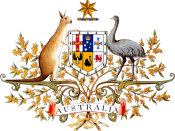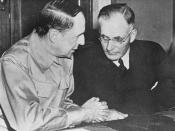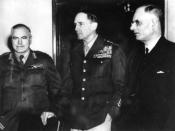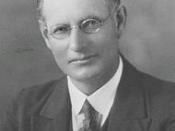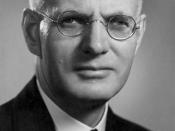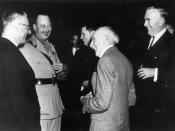The Australian war time government issued a number of controls upon Australian civilians throughout the war-time period of WWII including: manpower controls, censorship, rationing and conscription.
The Australian government during World War II had greater powers over money and manpower than any Australian authority at the time. Co-ordinating the war became its main concern and in 1939 the ÃÂNational Security ActÃÂ passed giving the government new powers and controls such as the right to prohibit public meetings, arrest people without warrants, carry out trials in closed court rooms and also control banking, wages and prices. The government forced the Commonwealth bank to limit interest rates under this act.
On 11th November 1939, Menzies created an economic cabinet; a committee of high ranking government officials who had the duty of taking care of the ÃÂbusiness side of warÃÂ. This gave the government control over private business activities, a power the government did not have prior to the war.
The new Prime Minister, John Curtin, set up the Production Executive of Cabinet which was responsible for devising an able plan and settled policy in terms of manpower, production and financial recourses. This gave the government a greater say in what would be produced by the industry. As more men and women left for military service, the government faced a dire shortage of labour in all industries. Manpower was the term used for the human resources and labour needed to make the economy function properly. Women started to fill in the vacancies in occupations left from the men who went to war but did not provide the numbers needed, so in January 1942, the government formed the ÃÂDirectorate of manpowerÃÂ.
The commission made priorities for the economy, and changed the composition of the workforce by allocating men to different industries needed to fuel the war. The number of people employed in factories not related to the war effort decreased sharply. Such non-essential occupations included clothing manufacturing, furniture and brick-making. The highest priority was given to the manufacturing of weapons. But, as the attention was directed away from the "non-essential" products, shortages of goods increased resulting in an extreme shortage of firewood which led to families turning to gas. This forced the government to ration gas.
As resources were being concentrated on the war effort rationings were introduced by the government. Rationing is assigning people a fixed allowance of essential and non-essential goods. It was intended as a way in which Australians could contribute to the war effort through sacrifice of certain luxuries and foods. Rationing was supported by most Australians because it ensured that everyone would be able to access essential items. Most Australians were able to obtain a fair share of essential item regardless of income.
Ration books and coupons were printed and were organised to be distributed. The cash to a coupon economy was established in which all shops participated in.
Each Australian citizen received a ration book with 112 coupons. Purchasable items had a coupon value, for example, a man's suit for 38 coupons, whereas a pair of socks cost 4.
Many everyday items were rationed in the period of WWII some being tea, sugar, butter, meat, coffee, rice, prunes, potatoes, and many fresh fruits and vegetables. Strict rationing was applied to petrol as it was already in short supply prior to the war. The Austerity Campaign was also introduced by mid 1942 which involved living as simple as possible. The message was ÃÂsave and save AustraliaÃÂ.
Upon the outbreak of World War II, Prime Minister Robert Menzies instituted conscription for militia operating in Australia and its territories. All unmarried men aged 21 and over were required to attend three months of compulsory military training. The Australian government did not have the intention of changing this conscription policy.
For the early years of World War II, the Australian public did not like the idea of mandatory overseas military service for its citizens. In 1941, John Curtin was elected Prime Minister of the Labor government. In World War he argued aggressively against conscription and was jailed for a short period. When Curtin became Prime Minister, he assumed responsibility for Australia's war effort and defence, and the threat of Japan changed Curtin's view on conscription.
Australian soldiers had been seriously injured, had caught diseases and were suffering from exhaustion. If Australia's war effort was to be taken seriously by the rest of the world, and provide adequate defense for the Australian mainland, drastic changes in recruitment needed to be made.
He needed Australian conscript soldiers to fight the Japanese in the Pacific, but at that time they were limited to the Australian mainland and her territories. In November 1942, Curtin asked the Labor conference to approve a plan to extend the territory in which Australian conscripts could operate to include the south-west Pacific. The Labor Party was not impressed by the suggestion. It had always argued against conscription for overseas service. Curtin's suggestion caused many Labor Party members to question his loyalty.
On 19 February 1943, the Labor government ceded to the demands of Curtin and allowed the conscripted Australian Military Forces (AMF) to be sent to fight in the south-west Pacific, except for the Philippines, Western Java and Northern Borneo. There was some discontent about the change in policy, however the majority of Australians were concerned about the Japanese threat and thought any defense the Australian government could provide was welcomed.
The compulsory military service came to an end in 1945.
In Australia during World War II, the governments exercised significant powers over censorship and were careful in the release of sensitive information to the public.
The government created the Department of Information, overseen by the Director-General of Information, newspaper-owner Keith Murdoch. The department was given wide-ranging powers to suppress information and direct newspapers towards a ÃÂgovernment-approvedÃÂ opinion.
Censorship was seen not only as an important tool to stop the enemy from learning important information, but also to maintain public morale and enthusiasm for the war.
The military forces were depleted, ships and planes obsolete, troops untrained but all this was censored to the Australian public. Also the death toll given to the public when the Japanese attacked Darwin was greatly reduced to avoid panic and distress.
The war-time Australian government held a greater number of powers over civilian life than when in times of peace. Most of the controls issued upon civilian life was for the benefit of the war and solely in protecting Australia so there could be an Australia to protect in the future.
BIBLIOGRAPHYhttp://wiki.answers.com/Q/How_and_why_was_manpower_controlled_in_Australia_during_World_War_2http://www.skwirk.com.au/p-c_s-14_u-91_t-201_c-673/censorship-and-propaganda/nsw/history/australia-and-world-war-ii/government-controlhttp://www.skwirk.com.au/p-c_s-14_u-91_t-201_c-674/rationing-and-other-controls/nsw/history/australia-and-world-war-ii/government-controlhttp://members.trump.net.au/ahvem/Fisheries/National/c5.htmlwww.competitioncommission.org.uk/rep_pub/reports/1950_1959/fulltext/007c03.pdf
